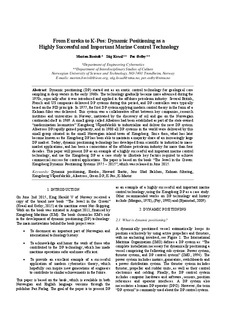| dc.contributor.author | Breivik, Morten | |
| dc.contributor.author | Kvaal, Stig | |
| dc.contributor.author | Østby, Per | |
| dc.date.accessioned | 2017-08-08T06:35:47Z | |
| dc.date.available | 2017-08-08T06:35:47Z | |
| dc.date.created | 2015-09-30T20:23:21Z | |
| dc.date.issued | 2015 | |
| dc.identifier.citation | IFAC-PapersOnLine. 2015, 48 (16), 313-323. | nb_NO |
| dc.identifier.issn | 2405-8963 | |
| dc.identifier.uri | http://hdl.handle.net/11250/2450071 | |
| dc.description.abstract | Dynamic positioning (DP) started out as an exotic control technology for geological core sampling in deep waters in the early 1960s. The technology gradually became more advanced during the 1970s, especially after it was introduced and applied in the offshore petroleum industry. Several British, French and US companies delivered DP systems during this period, and DP controllers were typically based on the PID principle. In 1977, the first DP system applying modern control theory in the form of a Kalman filter was delivered. This system was a collaborative effort between key companies, research institutes and universities in Norway, motivated by the discovery of oil and gas on the Norwegian continental shelf in 1969. A small group called Albatross had been established as part of the state-owned “modernization locomotive” Kongsberg Våpenfabrikk to industrialize and deliver the new DP system. Albatross DP rapidly gained popularity, and in 1980 all DP systems in the world were delivered by this small group situated in the small Norwegian inland town of Kongsberg. Since then, what has later become known as the Kongsberg DP has been able to maintain a majority share of an increasingly large DP market. Today, dynamic positioning technology has developed from scientific to industrial to massmarket applications, and has been a cornerstone of the offshore petroleum industry for more than four decades. This paper will present DP as an example of a highly successful and important marine control technology, and use the Kongsberg DP as a case study to illustrate key factors required to achieve commercial success for control applications. The paper is based on the book “The Jewel in the Crown: Kongsberg Dynamic Positioning Systems 1975 – 2015”, which was released in June 2015. | nb_NO |
| dc.language.iso | eng | nb_NO |
| dc.publisher | Elsevier | nb_NO |
| dc.relation.uri | http://www.sciencedirect.com/science/article/pii/S2405896316000021 | |
| dc.rights | Attribution-NonCommercial-NoDerivatives 4.0 Internasjonal | * |
| dc.rights.uri | http://creativecommons.org/licenses/by-nc-nd/4.0/deed.no | * |
| dc.title | From Eureka to K-Pos: Dynamic Positioning as a Highly Successful and Important Marine Control Technology | nb_NO |
| dc.type | Journal article | nb_NO |
| dc.type | Peer reviewed | nb_NO |
| dc.description.version | acceptedVersion | nb_NO |
| dc.source.pagenumber | 313-323 | nb_NO |
| dc.source.volume | 48 | nb_NO |
| dc.source.journal | IFAC-PapersOnLine | nb_NO |
| dc.source.issue | 16 | nb_NO |
| dc.identifier.doi | 10.1016/j.ifacol.2016.01.001 | |
| dc.identifier.cristin | 1277412 | |
| dc.relation.project | Norges forskningsråd: 223254 | nb_NO |
| dc.description.localcode | This is the authors' accepted and refereed manuscript to the article. | nb_NO |
| cristin.unitcode | 194,63,25,0 | |
| cristin.unitcode | 194,62,40,0 | |
| cristin.unitname | Institutt for teknisk kybernetikk | |
| cristin.unitname | Institutt for tverrfaglige kulturstudier | |
| cristin.ispublished | true | |
| cristin.fulltext | postprint | |
| cristin.qualitycode | 1 | |

